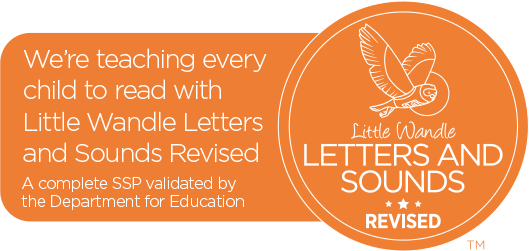Phonics
Welcome to the beginning of the most wonderful journey in which your child, whatever their starting point, will become a fluent, confident reader who loves books! For many children at the start of Reception, letters look like squiggles on the page and have no connection to sounds. Learning that letters and sounds are linked – phonics – is the key to reading.
At Warboys Primary Academy we believe that for all our children to become fluent readers and writers, phonics must be taught through a systematic and structured phonics programme.
We use the Little Wandle Letters and Sounds Revised to plan and provide daily engaging phonics lessons. In phonics, we teach children that the letters of the alphabet represent a different sound, that these can be used in a variety of combinations and are put together to make words. Children learn to recognise all of the different sounds and combinations that they might see when they are reading or writing.
Our phonics teaching follows on from nursery and follows a very specific sequence that allows our children to build on their previous phonic knowledge and master specific phonic strategies as they move through school. As a result, all our children are able to tackle any unfamiliar words that they might discover. At Warboys Primary we also model these strategies in shared reading and writing both inside and outside of the phonics lesson and across the curriculum. We have a strong focus on the development of language skills for our children because we know that speaking and listening are crucial skills for reading and writing in all subjects.
Why learning to read is so important
- Reading is essential for all subject areas and improves life chances.
- Positive attitudes to reading and choosing to read have academic, social and emotional benefits for children.
How children learn to read
- Phonics is the only route to decoding.
- Learning to say the phonic sounds.
- By blending phonic sounds to read words.
- Increasing the child’s fluency in reading sounds, words and books.
Reading fully decodable books
- Children must read books consistent with their phonic knowledge.
- It is essential not to use other strategies to work out words (including guessing words, deducing meaning from pictures, grammar, context clues or whole word recognition).
- Books must be fully decodable and follow the Little Wandle scheme.
- Children need to read books in a progressive sequence until they can decode unfamiliar words confidently.
The role of Parents’ and Carers’
- Have a positive impact on their child’s reading.
- Should model the importance of reading practice to develop fluency.
- Children take home books they have read at school to re-read at home to build fluency.
- There are two different types of books that pupils bring home: reading practice and books to share for pleasure.
- Reading at home encourages a love of books, along with developing vocabulary and discussion.
- Parents should use voices, expression, discuss unfamiliar vocabulary, talk about the pictures, and predict what might happen next.
Supporting your child with reading
Although your child will be taught to read at school, you can have a huge impact on their reading journey by continuing their practice at home.
There are two types of reading book that your child may bring home:
A reading practice book/ Ebook
This will be at the correct phonic stage for your child. They should be able to read this fluently and independently.
A sharing book
Your child will not be able to read this on their own. This book is for you both to read and enjoy together.
Reading practice book
This book has been carefully matched to your child’s current reading level. If your child is reading it with little help, please don’t worry that it’s too easy – your child needs to develop fluency and confidence in reading.
Listen to them read the book. Remember to give them lots of praise – celebrate their success! If they can’t read a word, read it to them. After they have finished, talk about the book together.
Sharing book
In order to encourage your child to become a lifelong reader, it is important that they learn to read for pleasure. The sharing book is a book they have chosen for you to enjoy together.
Please remember that you shouldn’t expect your child to read this alone. Read it to or with them. Discuss the pictures, enjoy the story, predict what might happen next, use different voices for the characters, explore the facts in a non-fiction book. The main thing is that you have fun!
Videos
These three videos show you how to pronounce the sounds. Notice how the children don’t add an ‘uh’ sound at the end, so they say: ‘t’ not ‘tuh’.
Phase 2 sounds taught in Reception Autumn 1
Phase 2 sounds taught in Reception Autumn 2
Phase 3 sounds taught in Reception Spring 1
How we teach blending
Quick guide to Alien words
How we teach tricky words
Parents support and information - Little Wandle website link

